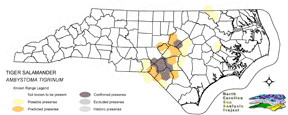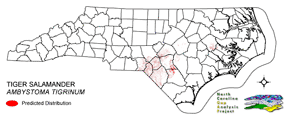
| Taxa: |
| Order: |
| Family: |
| Amphibia |
| Caudata |
| Ambystomatidae |
| NatureServe Global Rank: |
| NatureServe State (NC) Rank: |
| G5 |
| S2 |
| Federal Status: |
| NC State Status: |
| --- |
| T |


| Land Unit |
| US Fish & Wildlife Service |
| US Forest Service |
| US National Park Service |
| US Department of Defense |
| NC State Parks |
| NC University System |
| NC Wildlife Res. Com. |
| NC Forest Service |
| NC Div. of Coastal Mgmt. |
| Local Governments |
| Non-Governmental Org. |
| Other Public Lands |
| Private Lands |
| GAP Status 1-2 |
| All Protected Lands |
| Statewide |
| Hectares |
| 82.44 |
| 0.00 |
| 10,688.85 |
| 0.00 |
| 973.08 |
| 71.28 |
| 6,592.59 |
| 209.70 |
| 0.00 |
| 6.75 |
| 104.49 |
| 2.16 |
| 82,745.46 |
| 3,230.01 |
| 18,498.96 |
| 101,476.80 |
| Acres |
| 203.71 |
| 0.00 |
| 26,412.72 |
| 0.00 |
| 2,404.53 |
| 176.14 |
| 16,290.64 |
| 518.18 |
| 0.00 |
| 16.68 |
| 258.20 |
| 5.34 |
| 204,468.44 |
| 7,981.53 |
| 45,711.92 |
| 250,754.58 |
| % of Dist. on |
| Prot. Lands |
| 0.4 % |
| 0.0 % |
| 57.8 % |
| 0.0 % |
| 5.3 % |
| 0.4 % |
| 34.5 % |
| 1.1 % |
| 0.0 % |
| 0.5 % |
| 0.5 % |
| < 0.1 % |
| 0.0 % |
| 17.5 % |
| ----- |
| ----- |
| % of Dist. on |
| All Lands |
| < 0.1 % |
| 0.0 % |
| 10.5 % |
| 0.0 % |
| 1.0 % |
| < 0.1 % |
| 6.5 % |
| 0.2 % |
| 0.0 % |
| < 0.1 % |
| 0.1 % |
| < 0.1 % |
| 81.5 % |
| 3.2 % |
| ----- |
| ----- |
|
The tiger salamander is rare in the low country of Atlantic coast states (Martof et al. 1980). In the coastal plain and sandhills of North Carolina, sandy soil appears to be an important component to the salamander's distribution (Martof et al. 1980, Wilson 1995). The salamander has been found in a variety of forested situations where permanent and seasonal breeding ponds are located. In the coastal plain, breeding populations are often concentrated in, yet not restricted to, lowland flats where temporary pools form (Wilson 1995, Petranka 1998). NATURE SERVE GLOBAL HABITAT COMMENTS: Found in virtually any habitat, providing there is a terrestrial substrate suitable for burrowing and a body of water nearby suitable for breeding. Terrestrial adults usually are underground, in self-made burrows or in those made by rodents or other animals. At high elevations in the Rocky Mountains, metamorphosed adults commonly occur in ponds throughout the summer. Eggs are attached to submerged objects or pond bottom. Breeds in a wide range of environments, ranging from clear mountain ponds to temporary, manure-polluted pools in the lowlands. Breeds usually in sites where predatory fishes are absent. In the mountains of western Colorado, associated with ponds that have silty bottoms, low alkalinity, and no fishes (Geraghty and Willey 1992). In the southeastern U.S., requires relatively flatwoods ponds that do not contain fishes. NATURE SERVE STATE HABITAT COMMENTS: Flatwoods communities, sandy soils and sandhills. |
| Code | Name | Description | NC Natural Heritage Program Equivalent |
| 158 | Coastal Plain Nonriverine Wet Flat Forests | Loblolly pine - Atlantic white-cedar - red maple - swamp tupelo saturated forests as well as forests dominated by loblolly, sweetgum, and red maple in non-riverine flats. | Non-riverine Wet Hardwood Forest |
| 87 | Pocosin Woodlands and Shrublands | Includes pond pine woodland, low pocosin and high pocosin shrub dominated areas. Canebrakes and bay forests may be present. | Pond Pine Woodlands, Peatland Canebrake, Small Depression Pocosin |
| 67 | Wet Longleaf or Slash Pine Savanna | Wet flatwoods and pine savannas, typically dominated by longleaf pines, but slash or pond pines may be the dominant pines. | Wet Pine Flatwoods |
| 97 | Mesic Longleaf Pine | Longleaf pine woodlands without a major scrub oak component. Slash or loblolly pines may be present as well. | Mesic Pine Flatwoods |
|
Gehlbach, F. R. 1967. Ambystoma tigrinum. Cat. Am. Amph. Rep. 52.1-52.4.
Collins, J. P., J. B. Mitton, and B. A. Pierce. 1980. AMBYSTOMA TIGRINUM:a multispecies conglomerate? Copeia 1980:938-941. Fernandez, P. J., Jr., and J. P. Collins. 1988. Effect of environment and ontogeny on color pattern variation in Arizona tiger salamanders (AMBYSTOMA TIGRINUM NEBULOSUM Hallowell). Copeia 198:928-938. Jones, T. R., et al. 1988. Systematic status and distribution of AMBYSTOMA TIGRINUM STEBBINSI Lowe (Amphibia:Caudata). Copeia 1988:621-635. Kraus, F. 1988. An empirical evaluation of the use of the ontogeny polarization criterion in phylogenetic inference. Systematic Zoology 37:106-141. Wissinger, S. A., and H. H. Whiteman. 1992. Fluctuation in a Rocky Mountain population of salamanders:anthropogenic acidification or natural variation? J. Herpetol. 26:377-391. Jones, T. R., A. G. Kluge, and A. J. Wolf. 1993. When theories and methodologies clash:a phylogenetic reanalysis of the North American ambystomatid salamanders (Caudata:Ambystomatidae). Systematic Biology 42:92-102. Allison, L. J., P. E. Brunkow, and J. P. Collins. 1994. Opportunistic breeding after summer rains by Arizona tiger salamanders. Great Basin Nat. 54:376-379. Jones, T. R., E. J. Routman, D. J. Begun, and J. P. Collins. 1995. Ancestry of an isolated subspecies of salamander, AMBYSTOMA TIGRINUM STEBBINSI Lowe:the evolutionary significance of hybridization. Molecular Phylogenetics and Evolution 4:194-202. Shaffer, H. B., and M. L. McKnight. 1996. The polytypic species revisited:genetic differentiation and molecular phylogenetics of the tiger salamander AMBYSTOMA TIGRINUM (Amphibia:Caudata) complex. Evolution 50:417-433. Irschick, D. J., and H. B. Shaffer. 1997. The polytypic species revisited:morphological differentiation among tiger salamanders (AMBYSTOMA TIGRINUM) (Amphibia:Caudata). Herpetologica 53:30-49. Bishop, S. C. 1941. The salamanders of New York. New YorkState Mus. Bull. 324:1-365. Geraghty, C., and R. Willey. 1992. Current habitat status of and anthropogenic impacts on the tiger salamander, AMBYSTOMA TIGRINUM NEBULOSUM. Abstract, 6th Annual Meeting of the Society for Conservation Biology, p. 61. Jones, T. R., and J. P. Collins. 1992. Analysis of a hybrid zone between subspecies of the tiger salamander (AMBYSTOMA TIGRINUM) in central New Mexico. J. Evol. Biol. 5:375-402. Pierce, B. A., and J. B. Mitton. 1980. Patterns of allozyme variation in AMBYSTOMA TIGRINUM MAVORTIUM and A. T. NEBULOSUM. Copeia 1980:594-605. Wilson, L. A. 1995. The Land Manager's Guide to the amphibians and reptiles of the South. Chapel Hill, NC: The Nature Conservancy. Petranka, J. W. 1998. Salamanders of the United States and Canada. Washington DC: Smithsonian Inst. Press. Harte, J., and E. Hoffman. 1989. Possible effects of acidic deposition on a Rocky Mountain population of the tiger salamander AMBYSTOMA TIGRINUM. Conservation Biology 3:149-158. Worthylake, K. M., and P. Hovingh. 1989. Mass mortality of salamanders (AMBYSTOMA TIGRINUM) by bacteria (ACINETOBACTER) in an oligotrophic seepage mountain lake. Great Basin Nat. 49:364-372. Semlitsch, R. D. 1983. Structure and dynamics of two breeding populations of the eastern tiger salamander, AMBYSTOMA TIGRINUM. Copeia 1983:608-616. Minton, S. A., Jr. 1972. Amphibians and reptiles of Indiana. Indiana Academy Science Monographs 3. v + 346 pp. Martof, B. S., W. M. Palmer, J. R. Bailey, and J. R. Harrison, III. 1980. Amphibians and reptiles of the Carolinas and Virginia. University of North Carolina Press, Chapel Hill, North Carolina. 264 pp. Vogt, R. G. 1981. Natural history of amphibians and reptiles of Wisconsin. Milwaukee Public Museum. 205 pp. Collins, J.T., Huheey, Knight & Smith. 1982. STANDARD COM. &CURRENT SCIENTIFIC NAMES FOR NORTH AMERICAN AMPHIBIANS & REPTILES. SOC. FOR THE STUDY OF AMPH. & REPT., COMMITTEE ON COMMON & SCIENTIFIC NAMES. MISC. PUB. HERP. CIRC. NO.1. Hammerson, G. A. 1982. Amphibians and reptiles in Colorado. Colorado Division of Wildlife, Denver. vii + 131 pp. Kraus, F. 1985. A new unisexual salamander from Ohio. Univ. Michigan Mus. Zool., Occas. Pap. 709:1-24. Stebbins, R. C. 1985. A Field Guide to Western Reptiles and Amphibians. Second Edition. Houghton Mifflin Company, Boston, Massachusetts. xiv + 336 pp. Lowcock, L. A., L. E. Licht, and J. P. Bogart. 1987. Nomenclature in hybrid complexes of AMBYSTOMA (Urodela:Ambystomatidae):no case for the erection of hybrid "species." Syst. Zool. 36:328-336. Kraus, F., et al. 1991. Two new triparental unisexual AMBYSTOMA from Ohio and Michigan. Herpetologica 47:429-439. Collins, J. P., T. R. Jones, and H. J. Berna. 1988. Conserving genetically distinctive populations:the case of the Huachuca tiger salamander (AMBYSTOMA TIGRINUM STEBBINSI Lowe). Pages 45-53 in B88SZA01NA. Mitchell, J. C. 1991. Amphibians and reptiles. Pages 411-76 in K. Terwilliger (coordinator). Virginia's Endangered Species:Proceedings of a Symposium. McDonald and Woodward Publishing Company, Blacksburg, Virginia. Corn, P. S., and F. A. Vertucci. 1992. Descriptive risk assessment of the effects of acidic deposition on Rocky Mountain amphibians. J. Herpetol. 26:361-369. Pechmann, J. H. K., et al. 1991. Declining amphibian populations:the problem of separating human impacts from natural fluctuations. Science 253:892-895. Shaffer, H. B., J. M. Clark, and F. Kraus. 1991. When molecules and morphology clash:a phylogenetic analysis of the North American ambystomatid salamanders (Caudata:Ambystomatidae). Systematic Zoology 40:284-303. |
For more information please contact them at:
NC-GAP Analysis Project
Dept. of Zoology, NCSU
Campus Box 7617
Raleigh, NC 27695-7617
(919) 513-2853
www.basic.ncsu.edu/ncgap